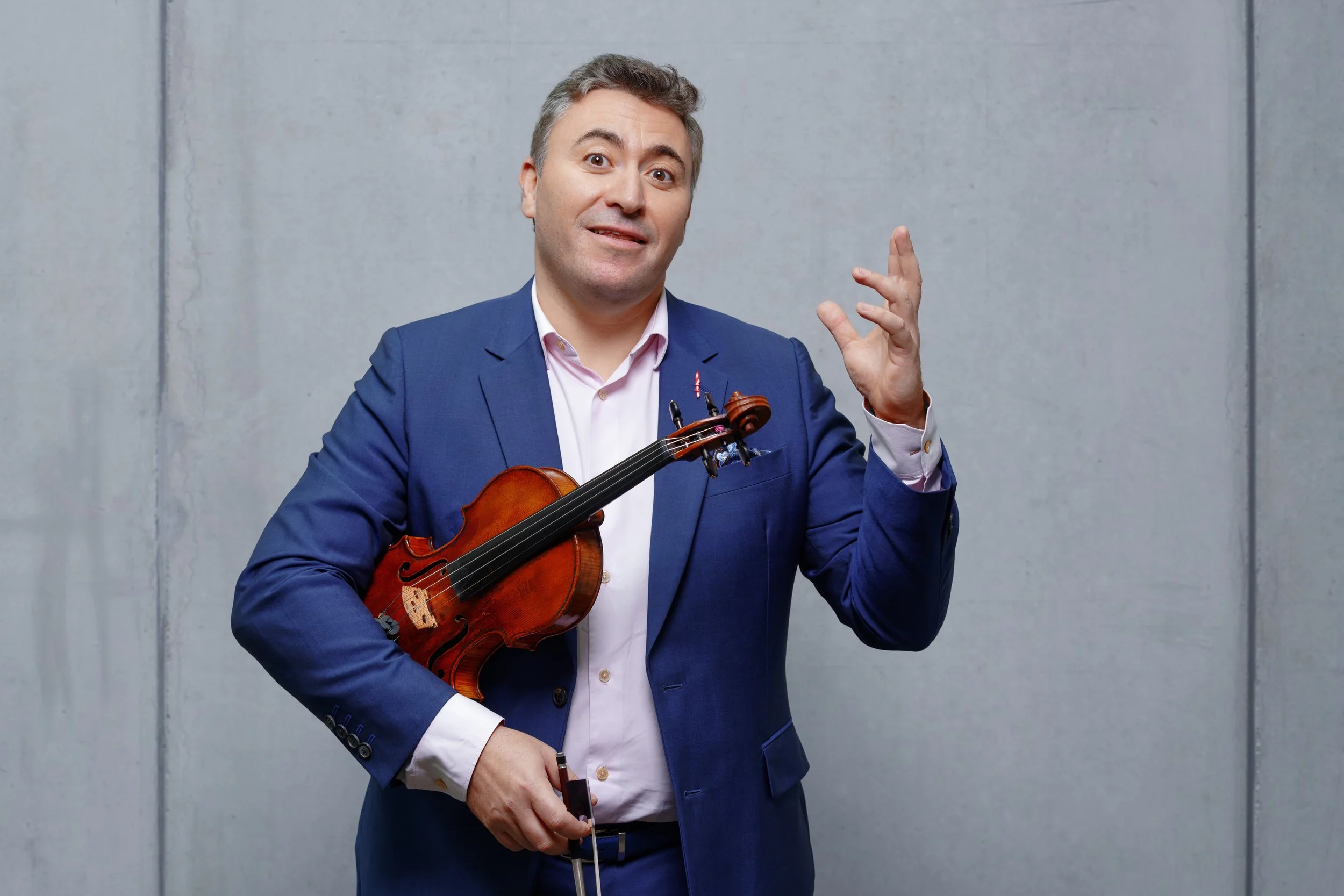
Vengerov’s Views
8 part exclusive educational teaching series
Part 1
Storytelling in Music
Photo © Christian Schneider
Introduction
Storytelling is as old as humankind. It is how we share our experiences with one another and understand the world around us. Through stories, we can transcend time and physical limitations, and extend our imagination beyond the scope of our own individual experience. A story lets us see the world through the eyes of another.
Alongside other art forms, music is a language for communication and storytelling. Through music, we can express things for which there may be no words. The greatest music and performances are not only aesthetic creations to be experienced from afar. We can sense the immediacy of another human spirit reaching out to tell us something. Art can foster a deep human connection that has the power to change us.
In this post, I will share some thoughts about how I approach storytelling as a performer, as well as some recommendations for how to discover your own stories in music and communicate these effectively to an audience.
Storytelling in music
“When you play, use your imagination to tell a story and bring the music to life.”
Instrumental music is without words, and usually there is not a specific image or association suggested by the composer. However, this does not mean the music is abstract or remote; it is up to us as performers to discover and communicate the story behind it.
The beauty is that there can be different stories, different interpretations. This is what keeps the music alive. As performers, we try to faithfully follow the composer's wishes, but we also bring our own heart and soul to every performance. We can think of ourselves as like a window illuminating the painting of an old master - every window will refract light slightly differently, bringing into relief different subtleties in the work.
When I teach, I try to help students form an interpretation that they created themselves. We explore the music together and imagine what the story could be. Images can be a powerful way to bring the music to life and visualize the story behind it. I find images can also be a helpful tool to inspire my students and spark their imagination. Often, an image can prompt them to think beyond the technical considerations and reconnect with the essence of the music, making their playing much more vivid and alive.
Sometimes, a particular painting or image can also fit well with a work. For example, in Ysaÿe’s Sonata no. 3 for solo violin, there is a specific moment where I can imagine the powerful expressionist painting “The Scream” by Edvard Munch. However, there is not only one possible image or association; this depends on the performer and what resonates with them, and can also change. Indeed, I often find myself using different images for the same works when I teach.
Of course, not all music lends itself well to a story or visual association. Some music is more absolute, more structural and architectural in nature — for example, German or Viennese classics. Here, you must think more about the structure, musical form, harmonies, character, and so on, to discover the message in the music.
What we think about, and what we feel when we play, is what comes across to the audience. This is something my mentor, Mstislav Rostropovich, once told me, which has always stuck in my mind. If we think of nothing, then the music is empty and radiates nothing. If our imaginations are alive, then even the most repetitive or difficult virtuoso passages become vivid music with a story to tell.
Discovering your own interpretation
“Study the score closely, until you have absorbed the music and it becomes your own”
To find your own vision of the story behind a musical work, I suggest you let your imagination run free without any limitations and experiment! In the privacy of your own room, you can push the boundaries — nobody will hear or judge your playing. Try not to get too hung up on technical difficulties — you can take care of these later. Just try things out, let yourself be a bit crazy, and see what happens!
Exercising your imagination when you practice is just as important as exercising your hands and body. However, at the same time, always stay connected to the source, which is the score. It is easy to get too carried away and deviate from the composer’s wishes, so keep in mind the boundaries, for example, the style and epoch of a work.
When you study a new work, try to absorb it and let it become yours, as if you have written it. This comes through the process of learning the score in depth and analyzing down to the details. I generally recommend to students to start by listening to a few interpretations whilst following the score - but then, once they have some auditory experience of the work, not to listen to recordings anymore, and to work directly from the score. In this way, they can find their own vision for a piece, which is informed by, but independent from, performance tradition.
Sometimes students listen to recordings and try to copy them; whilst this is well-intentioned, it is a pointless exercise because you cannot successfully copy anyone, and it means absolutely nothing to try and do so. Equally, it is a misguided exercise to study other interpretations and then try to be different, just for the sake of it - this approach is again derivative of the ideas of others and does not stem from a genuine individual understanding and honest representation of the original source, i.e. the score.
By working directly from the score, you will discover the irregularities, the structure, harmonies, and special characteristics of the work for yourself, and begin to inhabit the work and make it your own. Through this, you will discover how you feel about the work and how you want to present it to the audience. Ultimately as performers we are like ambassadors for the music, and if we do not absorb the music then we cannot present it and let it speak through us.
Sometimes, even with all this meticulous preparation, you make the biggest discoveries in the moment of performance itself. When you are in front of an audience, your whole nervous system is raised, your senses are heightened, and another part of your brain opens up. This adds another dimension and is why live performances can be so exciting. If you are inspired by the music, if you have goosebumps, then you can be sure the audience is getting some too!
Bringing your musical ideas across effectively to an audience
“For a listener sitting in the last row to understand your message clearly, you may need to exaggerate a little to bridge the distance.”
Playing to an audience is very different from playing to yourself. There is a distance between the performer and the listener, both visually and acoustically, and we must compensate for this when we play. Otherwise, like a game of Telephone, we may find that our intended message is not the one that reaches the audience — something may get lost or distorted across this gap. The larger the distance, the more we need to compensate: playing in an intimate setting is very different from performing in a big hall.
In order for your message to arrive intact, listen carefully to the acoustics of the room, and play to the person in the last row — if you can reach this person, you can be sure the people in the first row will get the message.
Just like an actor performing in a theater, we may need to exaggerate and articulate more than usual. (This is a very different craft from acting in a movie, where the camera is up close — this is more akin to making a recording.) You should clarify everything, and be very clear with the message you want to convey. Emphasize the contrasts, and be wary that finer details can get totally lost, especially with an orchestra behind you.
Drawing on an image in the moment of performance can also help you bring your message across to the audience. By bringing to your mind an image you feel is particularly evocative and suited to the music, your physical expression will be much stronger, and therefore so will the impact on the audience.
This does not mean the exact image will translate to the audience — even if I imagine “The Scream” when I play Ysaÿe’s Sonata no. 3, probably ninety-nine percent of the audience will not have this same association, but they will feel the energy. In this way, you help the audience make their own associations and connect directly with the music, and your performance becomes much more compelling.
To conclude
When we play music, we should always remember why we play. Musicians are not acrobats performing tricks, there is more to our craft than this — there is a message behind the music and a spark of connection from one human to another. It is not enough to have a good recipe and be a good cook - we need to know how to serve a meal and create an ambiance, just like in a great restaurant.
I hope these reflections give some food for thought and some practical advice on how to discover your own images and vision of the music you play. We must be storytellers: this is our art as performers.
Watch the full teaching video below, where I explain in further detail and demonstrate the concepts introduced in this article:
In this new educational series “Vengerov’s Views”, I cover key topics which come up frequently in my masterclasses, chosen to mirror the journey of learning. It all starts and ends with the source, the music, and understanding and telling the story behind it. And then along the way, as performers we must overcome some technical challenges to be able to bring our musical ideas to life.
By complementing the written articles with videos of examples selected from my masterclasses and performances, I hope to illustrate the concepts further and overcome the limitations of writing about music, and to create a useful educational resource. It has been an interesting challenge to document in writing for the first time some thoughts about my approach to music and playing the violin - let me know what you think!
This series was curated and co-written by Anna Gould, and released in partnership with The Violin Channel.

